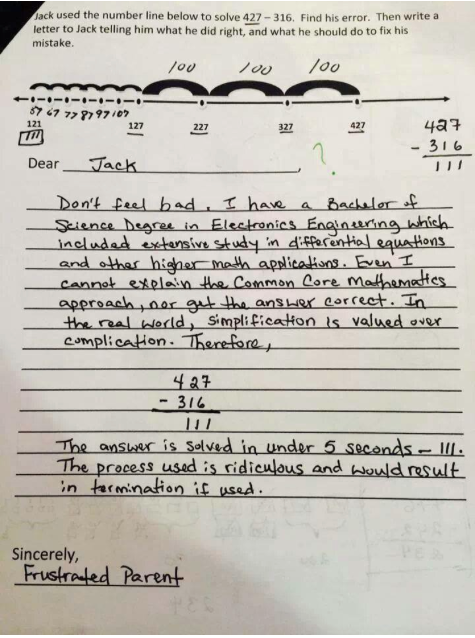Riddle Me This……
There is a lot of debate about the value of the Common Core Academic Content Standards, yet the loudest critics seem to have the weakest understanding. The problem is not with the standards. The problem is with the high-stakes measurements of those standards.
First and foremost, let me say this: there have ALWAYS been academic content standards. Your school had them, your parents’ schools had them, your grandparents’ schools had them. Horace Mann first introduced this concept when he developed the model for universal public education in 1838: level the playing field and provide equal access to education for all students. Over the years, educational theorists and policy makers have argued about, revised, and determined what students should know at each developmental age stop AND THIS IS A GOOD THING. Having measurable data to determine a student’s pace and skill level can only help teachers adjust delivery and methodology in the classroom. If the critics on social media sites would actually, you know, read the standards, I don’t think anyone would disagree that, for example, a second grader should be able to “build fluency with addition and subtraction” (the complete scope and sequence can be found here). They don’t, though (read, that is). Instead, they look at a worksheet posted by a friend on Facebook showing an alternate way to calculate that is different from how they learned which is produced by a curriculum company whose only interest is selling packaged curricula and raking in the millions hand over fist and determine that the Common Core must be abolished because it is the wrong way to math. These same parents then go on to insult the incompetent teacher who assigned that terrible worksheet and demand that she be fired because she is a bad teacher, despite her Master’s degree in Curriculum & Instruction & Child Development. These parents who may or may not have graduated with a GED are the experts on appropriate 2nd grade homework and how to teach. Please retweet.
My favorite is this one: the instructions clearly state to IDENTIFY THE ERROR JACK MADE WHEN SOLVING THE PROBLEM. It doesn’t say to SOLVE THE PROBLEM. It asks the student to analyze and to use higher level thinking skills and understanding of how numbers work and apply that knowledge to evaluate the example and identify the error. So, while “frustrated parent” may have a BS in Electronics Engineering, his reading comprehension skills are low. Very.

And this is a problem, you see, because we want students to be able to think critically, in addition to being able to solve math problems. We want them to understand how math works, not just memorize rote facts. And one way to help them understand how math works is to have them practice solving problems in a variety of different ways. And that, my friends, is the beauty of math: there is only one correct solution to an equation, but if the child has a toolbox full of strategies to use to solve it, s/he will be more successful more of the time.
If you made it this far, you’re probably wondering why I’m talking about math when I am an English Teacher? Because I’m tired. I’m tired of defending good standards that make my students smarter. I’m tired of parents and politicians who don’t understand my job and couldn’t do my job for 5 consecutive minutes who want to tell me I’m bad at my job. But most of all, I’m tired of testing my students with assessments that do not measure the standards.
I like the Common Core standards for ELA. I like that my students have regular practice with complex texts and their academic language. Specifically, “Rather than focusing solely on the skills of reading and writing, the ELA/literacy standards highlight the growing complexity of the texts students must read to be ready for the demands of college, career, and life. The standards call for a staircase of increasing complexity so that all students are ready for the demands of college- and career-level reading no later than the end of high school. The standards also outline a progressive development of reading comprehension so that students advancing through the grades are able to gain more from what they read.” (from http://www.corestandards.org/ELA-Literacy/) Who can argue with this?
The problem, then, is not the standards but the assessments. If the standards are universal (or common) from state to state, how come the tests are not? And, if the standards increase in skill and complexity and are vertically aligned, shouldn’t the items on the tests correspond to the grade level standards? Yes. Yes, they should. But they don’t.
Exhibit A: Here are some sample test items & reading passages from the English I End of Year Exam for Florida.
This selection is grade appropriate, as Homer’s Odyssey is a grade-level appropriate text and it is an appropriate complex text to be taught in English I.
Exhibit B: Here is a sample from the Ohio English I EOY exam: 
As you can see, this selection is from the American Transcendentalism Movement, most commonly taught in 10th or 11th grade. This item appears on the 9th grade test. Do you see the problem? It isn’t that the text isn’t an appropriate teaching resource to master a standard in the Common Core, it’s that it is being tested in a grade level one or two years before most curriculums will encounter it. And if the standards are supposed to be universal from state to state, shouldn’t the assessments be also?
50% of my teacher evaluation – my measurement of whether or not I am effective in the classroom – is derived from student achievement data. I have to show a year’s growth for all my students, including those with an Individualized Education Plan (IEP), yet my students are tested on material they have not yet encountered in the scope and sequence. The Emerson piece is excellent – it addresses Rhetoric, Pathos, Logos, Argument, as well as structure. It is a complex text used to teach close reading skills and to foster good writing skills. However, the philosophy of the Transcendentalists and the academic vocabulary in this piece are not grade level appropriate for 9th grade. This is the rail against the Common Core. The standards are not the problem, the tests are.
[/tatsu_text][/tatsu_column][/tatsu_row][/tatsu_section]




Recent Comments